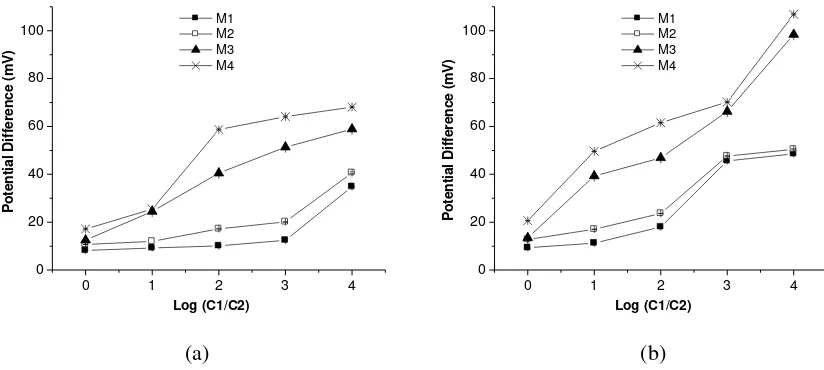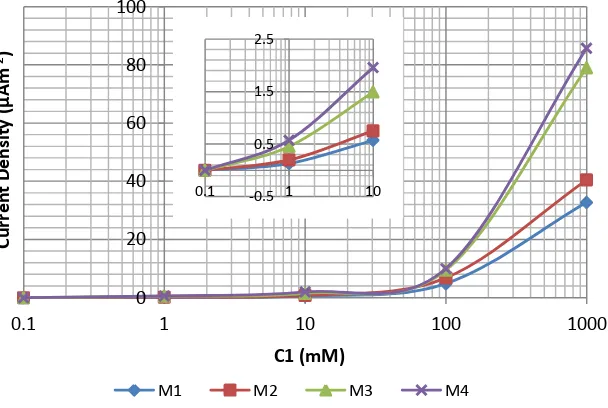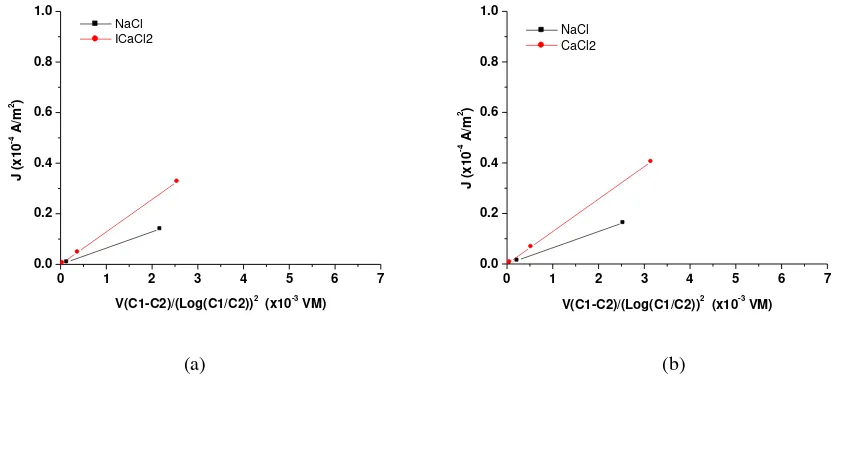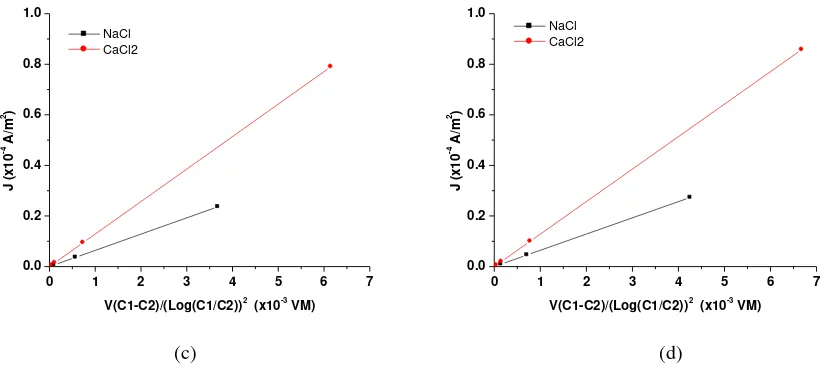This content has been downloaded from IOPscience. Please scroll down to see the full text.
Download details:
IP Address: 114.79.59.53
This content was downloaded on 02/07/2015 at 04:24
Please note that terms and conditions apply.
Transport phenomena in chitosan synthetic membranes with emphasis on the effect of
variations in the ratio of matrix/solvent
View the table of contents for this issue, or go to the journal homepage for more
Transport phenomena in chitosan synthetic membranes with
emphasis on the effect of variations in the ratio of
matrix/solvent
N Nyoman Rupiasih1,2,3,4, Yayuk Eka Puspita 1 and Made Sumadiyasa 1
1
Department of Physics, Faculty of Mathematics and Natural Sciences, Udayana University, Kampus Bukit Jimbaran, Badung, Bali 80362, Indonesia
2
Group Research Material Sciences and Technology-Polymer and Biomaterial
E-mail: rupiasih69@yahoo.com
Abstract. The object of this research was investigating the transport phenomena of chitosan synthetic membranes with emphasis on the effect of variations in the ratio of matrix/solvent. The study was focused on the effect of amount of chitosan as matrix and electrolytes solutions on the characteristics of current density of chitosan membranes. A series of chitosan membranes with various ratios of components was used such as 1%, 2%, 3% and 4%. The electrolytes solutions, NaCl and CaCl2, with various concentrations, 0.1 mM, 1 mM, 10 mM,
100 mM and 1000 mM, were used. Ion transport processes were carried out in a cell membrane model which composed of two compartments named compartment 1 and 2, and the potential difference was measured using a pair of Activon AEP jnct Single 12 x 120 mm calomel electrodes. All the measurements were conducted at room temperature, 28.8 oC. The result showed that the current density increased with some parameters e.g. increased in the ratio of concentration of solution, C1:C2; increased in the amount of chitosan, 1%, 2%, 3% and 4%; and increased in the size of Stokes radii ofthe selected cations, Na+ and Ca+2.
Keywords: Chitosan synthetic membrane, electrolyte solution, current density, ion diffusion
1. Introduction
Chitosan is a biopolymer composed of glucosamine and N-acetyl glucosamine units linked by 1-4 glucosidic bonds. It is a cationic polysaccharide obtained by de-N-acetylation of chitin under alkaline conditions [1-3]. Recently, chitosan has attracted great interest due to its specific properties such as biodegradability, biocompatibility, non-toxic, antibacterial, physiological inert and bioactivity [4-5]. These biological characteristics provide chitosan a wide field of applications as a material part in bio-environments systems, such as pharmaceutical and biomedical engineering, food industry, agriculture andwastewater treatment. Such applications involve as drug carriers, wound-healing agents, chelating
3
Author to whom any correspondence should be addressed: rupiasih69@yahoo.com; 4Grant: RM Udayana University No: 104.41/UN14.2/PNL.01.03.00/2014 date 3 Maret 2014
ScieTech 2015 IOP Publishing
agents, hemodialysis membranes and surgical dressing materials, biodegradable coating or film for
food packaging, coating of seeds and leaves to improve plants’ resistance to diseases, and coating of
fertilizers and pesticides for their controlled release to soil [1, 5-10]. Chitosan is readily converted to fibers, membranes, coatings, powders and solutions, further enhancing its usefulness [1].
Chitosan membranes have been used for active transport of chloride ions in aqueous solution [1]. The other applications are as a carrier and/or a selective barrier controlling the transport rate of the substances involved, chitosan having a powerful chelating ability provides protection of the systems against destructive effects of heavy metal ions [11].
The development of synthetic membranes had always been inspired by the fact that the selective transport through biological membranes is enabled by highly specialized macromolecular and supramolecular assemblies based on and involved in molecular recognition [12], the use of membranes as ion exchanger. The ion exchange membrane has been used for the traditional applications, such as electrodialysis concentration or desalting of solutions, diffusion dialysis to recover acids, and electrolysis of sodium chloride solution. Recently it also used in various fields as a polymeric film having ionic groups [13] such as ion-exchange membranes for protein separation [14].
Most ion-exchange membranes are made of synthetic polymers; only a few are from natural polymers e.g. chitosan, cellulose and alginate [14]. Chitosan can be used as an anion-exchange membrane directly [15], cellulose derivatives such as cellulose phosphate [16], cellulose acetate [17] and alginate [18] are used as cation-exchange membranes.
In the present study, we prepared a series of chitosan membranes by varying the ratio of components e.g. matrix/solvent. The purpose of this work was to study of transport phenomena in those various synthetic membranes. The effects of concentration and electrolytes on their characteristics were also reported.
2. Materials and methods
2.1 Materials
NaCl, CaCl2 and other reagents used in this study were obtained from commercial sources. 2.2 Transport in chitosan membranes
A series of chitosan membranes e.g. M1, M2, M3 and M4, have prepared by varying the ratios of components (matrix/solvent) such as 1%, 2%, 3% and 4% respectively. The electrolytes solutions used were NaCl and CaCl2 with various concentrations, 0.1 mM, 1 mM, 10 mM, 100 mM and 1000 mM.
Ion transport processes carried out in a cell membrane model which composed of two compartments named compartment 1 and 2, and the potential difference was measured using a pair of Activon AEP jnct Single 12 x 120 mm calomel electrodes. C1 and C2 is concentration of solution in compartment 1 and compartment 2, respectively. In the transport processes, C1 are varies as 0.1 mM, 1 mM, 10 mM, 100 mM and 1000 mM whereas C2 is kept constant 0.1 mM. All the measurements were conducted at room temperature, 28.8 oC.
3. Results and discussion
3.1 Characteristic of potential difference (V) vs Log (C1/C2)
Figure 1a and 1b show the potential difference of membranes as function of Log (C1/C2) when the membranes in contact with NaCl and CaCl2 solution, respectively. In general, Figure 1a and 1b show
that the potential difference (V) increased as increasing the ratio of concentration, C1:C2. This result is in accordance to the Nernst equation (Hobbie, Russell K, 1978) [19], which illustrates that the potential difference is due to differences in concentration in compartment 1 and 2 e.g. proportional to Log (C1/C2). Both figures also show that the increased of potential difference in CaCl2 solution was
bigger compared with NaCl solution, the graph look sharper.
ScieTech 2015 IOP Publishing
Journal of Physics: Conference Series622(2015) 012004 doi:10.1088/1742-6596/622/1/012004
0 1 2 3 4 0 20 40 60 80 100 P o te n ti a l D if fe re n c e ( m V ) Log (C1/C2) M1 M2 M3 M4
0 1 2 3 4
0 20 40 60 80 100 P o te n ti a l D if fe re n c e ( m V ) Log (C1/C2) M1 M2 M3 M4
(a) (b)
Figure 1. The potential difference (V) vs. Log (C1/C2) graphs of chitosan membranes in contact with a) NaCl solution and b) CaCl2 solution.
Figure 2a and 2b show the potential difference in each membrane in contact with various concentrations (0.1, 1, 10, 100 and 1000 mM) of NaCl and CaCl2 solution, respectively. It shows an
increased in the potential difference with increased in the amount of matrix constituents of membranes from 1%, 2%, 3% and 4% which named as membrane M1, M2, M3 and M4, respectively. This explains that increased in the amount of matrix constituent result a more positive membranes formed, which affects the diffusion characteristics of the membranes itself.
M1 M2 M3 M4
0 20 40 60 80 100 120 Petential Diffe re nc e (m V) Chitosan Membrane 0,1 (mM) 1 (mM) 10 (mM) 100 (mM) 1000 (mM)
M1 M2 M3 M4
0 20 40 60 80 100 120 Po ten tia
l Difference (mV)
Chitosan Membrane 0,1 (mM) 1 (mM) 10 (mM) 100 (mM) 1000 (mM)
(a) (b)
Figure 2. The potential difference (V) vs. chitosan membranes (M1, M2, M3 and M4) graphs in various concentrations e.g. 0.1, 1, 10, 100 and 1000 mM of a) NaCl solution and b) CaCl2
solution.
3.2 Characteristic of current density vs. Log (C1)
Figure 3 and Figure 4 show that at small ratios (C1: C2 is small) e.g. 0.1 mM : 0.1 mM, 1 mM : 0.1 mM and 10 mM : 0.1 mM, the current density (J) increased gently. The increased is rising sharply at bigger ratios e.g. 100 mM : 0.1 mM and at the highest ratio e.g. 1000 mM : 0.1 mM, the increased is
ScieTech 2015 IOP Publishing
very sharp. The both figures also show that the increased of the current density is greater when the membranes in contact with CaCl2 solution compared with NaCl solution. This result can be described
that the numbers of Cl-1 ions in CaCl2 solution are double compared in NaCl solution, that is one Cl -1
ion for one Na+ ion and two Cl-1 ions for one Ca2+ ion. These mean that the driving force is double when the membranes in contact with CaCl2 solution, the graphs in Figure 4 look sharper.
Figure 3. Current density vs. C1 (concentration of NaCl solution in compartment 1) semi log graphs.
Figure 4. Current density vs. C1 (concentration of CaCl2 solution in compartment 1) semi log
graphs. 0 20 40 60 80 100
0.1 1 10 100 1000
Cu rr e n t D e n si ty ( μ Am -2) C1 (mM)
M1 M2 M3 M4
-0.5 0.5 1.5 2.5
0.1 1 10
0 20 40 60 80 100
0.1 1 10 100 1000
Cu rr e n t D e n si ty ( μ Am -2) C1 (mM)
M1 M2 M3 M4
-0.5 0.5 1.5 2.5
0.1 1 10
ScieTech 2015 IOP Publishing
Journal of Physics: Conference Series622(2015) 012004 doi:10.1088/1742-6596/622/1/012004
Increasing the amount of matrix (chitosan) also affects ion transport characteristics of the membranes as shown in Figure 5. It shows that the current density is increased with increasing the amount of matrix e.g. 1%, 2%, 3% and 4% which named as membrane M1, M2, M3 and M4 respectively. This result is consistent with the increased in the value of the potential difference measured.
M1 M2 M3 M4
0 20 40 60 80 100 C u rr e n t D e n s it y ( Am -2 ) Chitosan Membrane 0,1 (mM) 1 (mM) 10 (mM) 100 (mM) 1000 (mM)
M1 M2 M3 M4
0 20 40 60 80 100 C u rr e n t D e n s it y ( Am -2 ) Chitosan Membrane 0,1 (mM) 1 (mM) 10 (mM) 100 (mM) 1000 (mM)
(a) (b)
Figure 5. Current density vs. chitosan membranes (M1, M2, M3 and M4) graphs in various concentrations (0.1, 1, 10, 100 and 1000 mM) of a) NaCl solution and b) CaCl2 solution.
3.3 Effect of electrolyte solutions on current density
Figure 6 describe the effect of electrolyte solutions to the ion transport characteristics of chitosan membranes. The graphs show similar pattern for all membranes, M1, M2, M3 and M4, e.g. the graph is sharper as membranes in contact with CaCl2 solution compared with NaCl solution. This is in
accordance with the increased in the size of Stokes radii of the selected cations, Na+ and Ca+2. The numbers of Cl-1 ions in CaCl2 solution are double compared in NaCl solution, that is one Cl
-1
ion for one Na+ ion and two Cl-1 ions for one Ca2+ ion.
0 1 2 3 4 5 6 7
0.0 0.2 0.4 0.6 0.8 1.0 J ( x 1 0
-4 A
/m 2 ) V(C1-C2)/(Log(C1/C2))2 (x10-3 VM) NaCl ICaCl2
0 1 2 3 4 5 6 7
0.0 0.2 0.4 0.6 0.8 1.0 J ( x 1 0
-4 A
/m
2)
V(C1-C2)/(Log(C1/C2))2 (x10-3 VM) NaCl
CaCl2
(a) (b)
ScieTech 2015 IOP Publishing
0 1 2 3 4 5 6 7 0.0 0.2 0.4 0.6 0.8 1.0 J ( x 1 0
-4 A
/m 2 ) V(C1-C2)/(Log(C1/C2))2 (x10-3 VM) NaCl CaCl2
0 1 2 3 4 5 6 7
0.0 0.2 0.4 0.6 0.8 1.0 J ( x 1 0
-4 A
/m 2 ) V(C1-C2)/(Log(C1/C2))2 (x10-3 VM) NaCl CaCl2
(c) (d)
Figure 6. Current density vs. {V(C1-C2) / (Log(C1/C2))2}, subsequently: a) M1, b) M2, c) M3 and d) M4.
4.
ConclusionThe study about transport phenomena in chitosan synthetic membranes with emphasis on the effect of variations in the ratio of matrix/solvent has been described. The results showed that the current density is increased with some parameters such as increased in the ratio of concentration of solution, C1:C2; increased in the amount of matrix (chitosan), 1%, 2%, 3% and 4% which named as M1, M2, M3 and M4 respectively; and increased in the size of Stokes radii ofthe selected cations, Na+ and Ca+2.
Acknowledgments
This work was financially supported by the Ministry of National Education, Republic of Indonesia, under Fundamental Research Grant of Udayana University No: 023.04.2.415253/2014, 5 December 2013, MAK 2013.109.011.521119, Year Budget 2014 are highly acknowledged.
References:
[1] Ying Wan, Katherine A. M. Creber, Brant Peppley and V. Tam Bui, 2003, Synthesis, Characterization and Ionic Conductive Properties of Phosphorylated Chitosan Membranes.
Macromol. Chem. Phys. 204, pp 850-858.
[2] Jolanta Kumirska, Mirko X. Weinhold, Jorg Thöming and Piotr Stepnowski, 2011, Biomedical Activity of Chitin/Chitosan Based Materials-Influence of Physicochemical Properties Apart from Molecular Weight and Degree of N-Acetylation. Polymers3, pp 1875-1901.
[3] Srinivasa R. Popuri, Y. Vijaya, Veera M. Boddu and Krishnaiah Abburi, 2009, Adsorptive removal of copper and nickel ions from water using chitosan coated PVC beads. Bioresource Technology100, pp 194-199.
[4] Krajewska B, 2004, Application of chitin-and chitosan-based materials for enzyme immobilizations: a review. Enzyme and Microbial Technology35, pp 126-139.
[5] Sandford PA, 1989, Chitosan: Commercial Uses and Potential Applications. In: Skjak-Braek G, Anthonsen T, Sandford P. Chitin and Chitosan – Sources, Chemistry, Biochemistry, Physical Properties and Applications. London: Elsevier Applied Science, pp 51-69.
[6] Dutta PK, Rayikumar MNV and Dutta J, 2002, Chitin and chitosan for versatile applications.
Journal of Macromolecular Science, C42 (3), pp 307-354.
[7] Brine CJ, 1989, Controlled Release Pharmaceutical Applications of Chitosan. In: Skjak-Braek G, Anthonsen T, Sandford P (Eds.). Chitin and Chitosan – Sources, Chemistry, Biochemistry,
ScieTech 2015 IOP Publishing
Journal of Physics: Conference Series622(2015) 012004 doi:10.1088/1742-6596/622/1/012004
Physical Properties and Applications. London: Elsevier Applied Science, pp 679-691.
[8] Ueno H, Yamada H, Tanaka I, Kaba N, Matsuura M, Okumura M, Kadosawa T and Fujinaga T. 1999, Accelerating effects of chitosan for healing at early phase of experimental open wound in dogs. Biomaterials20, pp 1407-1414.
[9] Cho YW, Cho YN, Chung SH, Yoo G and Ko SW, 1999, Water-soluble chitin as a wound healing accelerator. Biomaterials20, pp 2139-2145.
[10] Hadwiger, LA, Fristensky B and Riggleman RC. Chitosan, 1984, A Natural Regulator in Plant-Fungal Pathogen Interactions, Increases Crop Yields. In: Zikakis JP (Ed.). Chitin, Chitosan, and Related Enzymes. Orlando: Academic Press, pp 291-302.
[11] Barbara Krajewska, 2001, Diffusion of metal ions through gel chitosan membranes, Reactive & Functional Polymers47, pp 37-47.
[12] Mathias Ulbricht, 2006, Advanced functional polymer membranes. Polymer47, pp 2217-2262. [13] T. Sata, 1991, Ion Exchange Membranes and Separation Processes with Chemical Reactions.
Reviews Of Applied Electrochemistry 26, Journal Of Applied Electrochemistry 21, pp 283-294.
[14] Xin Chen, Jiahao Liu, Zhicheng Feng and Zhengzhong Shao, 2005, Macroporous
Chitosan/Carboxymethylcellulose Blend Membranes and Their Application for Lysozyme
Adsorption. Journal of Applied Polymer Science96, pp 1267-1274.
[15] Zeng, X. F. and Ruckenstein, E. 1998, J Membr Sci148, p. 195.
[16] Li, W., Zhao, H., Teasdale, R. R., John, R. and Zhang, S. 2002, Anal Chim Acta464, p. 331.
[17] Barragan, V. M., Rueda, C. and Ruizbauza, C. J 1995, Colloid Interface Sci, 172, p. 361.
[18] Zhang, L. N., Zhou, J. R., Zhou, D. C. and Tang, Y. R. 1999, J Membr Sci162, p. 103.
[19] Hobbie, Russel K. 1978, Intermediate Physic for Medicine and Biology. Second Edition. John Willey and Son. Singapore, pp 45-105.
ScieTech 2015 IOP Publishing
Transport phenomena in
chitosan synthetic membranes
with emphasis on the effect of
variations in the ratio of matrix
solvent
by
Ni Nyoman Rupiasih
FILE
T IME SUBMIT T ED 26- JAN- 2016 05:40AM
SUBMISSION ID 623938237
WORD COUNT 2100
17
%
SIMILARIT Y INDEX
13
%
INT ERNET SOURCES
16
%
PUBLICAT IONS
10
%
ST UDENT PAPERS
1
1
%
2
1
%
3
1
%
4
1
%
5
1
%
6
1
%
7
1
%
Transport phenomena in chitosan synthetic membranes with
emphasis on the effect of variations in the ratio of matrix
solvent
ORIGINALITY REPORT
PRIMARY SOURCES
Ulbricht, M.. "Advanced functional polymer
membranes", Polymer, 20060322
Publicat ion
www.vetmed.hokudai.ac.jp
Int ernet SourceYing Wan. "Synthesis, Characterization and
Ionic Conductive Properties of
Phosphorylated Chitosan Membranes",
Macromolecular Chemistry and Physics,
04/2003
Publicat ion
www.rsu.ac.th
Int ernet Sourceshodhganga.inflibnet.ac.in
Int ernet Source
Submitted to 8936
St udent Paper8
1
%
9
1
%
10
1
%
11
1
%
12
1
%
13
1
%
14
1
%
15
1
%
Crustaceans", Marine Biotechnology, 06/2006
Publicat ion
Submitted to University of Warwick
St udent Paper
www.slideshare.net
Int ernet Source
Submitted to University of Northampton
St udent Paperetd.lib.fsu.edu
Int ernet SourcePawlicka, A., R.I. Mattos, C.E. Tambelli, I.D.A.
Silva, C.J. Magon, and J.P. Donoso.
"Magnetic resonance study of chitosan
bio-membranes with proton conductivity
properties", Journal of Membrane Science,
2013.
Publicat ion
Jayakumar, R., M. Prabaharan, P. T.
Sudheesh Kumar, S. V., T. Furuike, and H.
Tamur. "Novel Chitin and Chitosan Materials
in Wound Dressing", Biomedical Engineering
Trends in Materials Science, 2011.
Publicat ion
Submitted to 7034
St udent Paper16
1
%
17
1
%
18
1
%
EXCLUDE QUOT ES ON
EXCLUDE BIBLIOGRAPHY
OFF
EXCLUDE MAT CHES < 1%
Materials Letters, 200305
Publicat ionXiashi Zhu. "Determination of Trace
Cadmium in Water Samples by Graphite
Furnace Atomic Absorption Spectrometry
after Cloud Point Extraction", Microchimica
Acta, 04/2006
Publicat ion
Submitted to The University of the South
Pacific
St udent Paper



